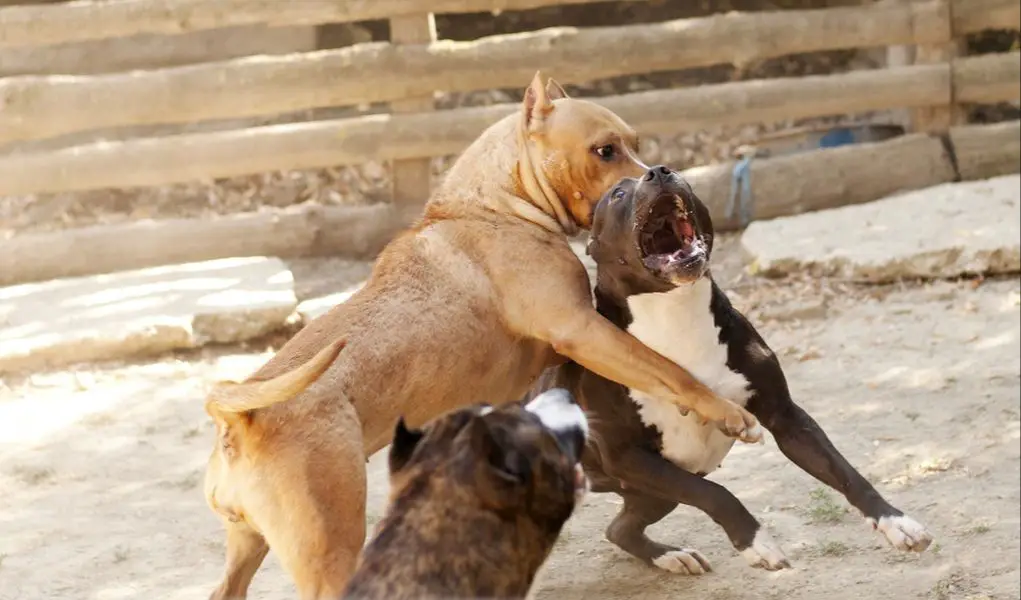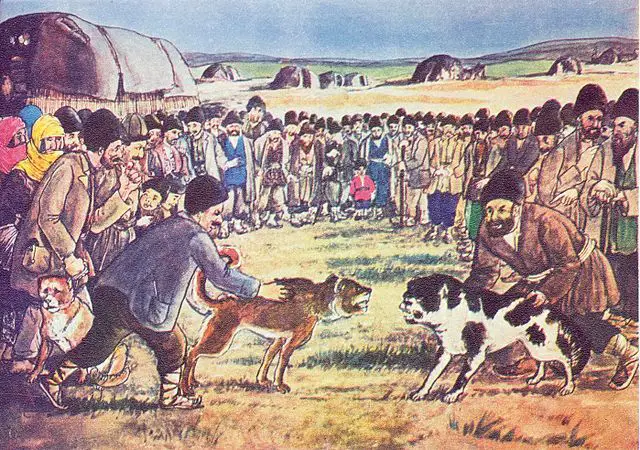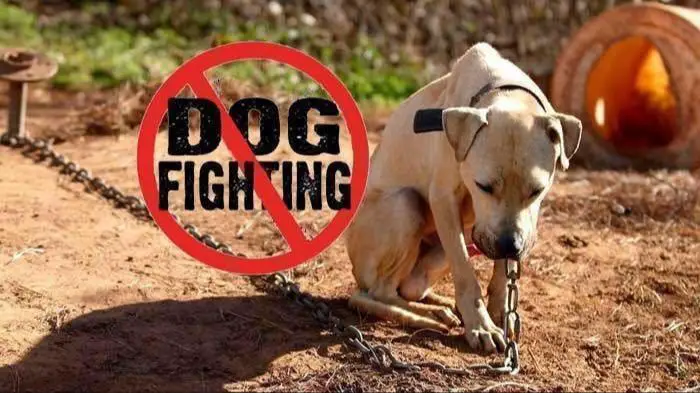Introduction
Dog fighting is a brutal and illegal blood sport that involves forcing two dogs to fight each other in a ring or pit for the purposes of gambling and entertainment. Though dog fighting has existed for centuries in various parts of the world, it continues to persist as an underground activity despite being outlawed in most countries. The practice is extremely inhumane, often resulting in severe injuries and death for the dogs involved.
There is no valid justification for forcing dogs to participate in vicious fights for human profit and entertainment. Dog fighting inflicts tremendous physical and psychological suffering on the animals, going against basic values of compassion and humanity. The dogs used in fights are victims, not willing participants, and they endure abusive training regimens focused on increasing aggression and tenacity. As a society, we must recognize that dog fighting is cruel and unjustifiable, and that there are better forms of entertainment that do not involve animal abuse.
History of Dog Fighting
The origin of dog fighting as a “sport” can be traced back hundreds of years. Unfortunately, pitting dogs against each other in bloody combat for entertainment has existed across multiple cultures and continents. One of the earliest forms of dog fighting emerged in ancient Rome, where large crowds would gather at colosseums to watch fights between various animals, including dogs. These brutal spectacles often ended in the death of the animals.
In medieval England, dog fighting gained popularity among nobility as a form of entertainment. Selective breeding was used to develop dogs like the Old English Bulldog for the specific purpose of dog fighting. When the British colonized North America and other parts of the world, they brought their practice of dog fighting along with them.
Eventually, dog fighting evolved from an activity of the upper class to a more underground subculture. However, it continued to persist, supported by gambling, crime syndicates, and enthusiasts of the “sport.” Unfortunately, the inherent cruelty and abuse entailed by dog fighting has made it incredibly difficult to fully stamp out despite being banned and criminalized in most parts of the world today.
Purpose of Putting Soap on Fighting Dogs
Unfortunately, some people force dogs to fight each other for entertainment and gambling purposes. This barbaric practice involves various tactics to try to give dogs an advantage in the fight or minimize injuries.
One common tactic is to put soap on a dog’s coat before a fight. The soap serves to make the dog’s fur slick and slippery. When dogs are fighting, they will often try to grip each other with their teeth to gain leverage and tackle their opponent. By covering a dog in soap, it makes it more difficult for the opposing dog to get a good grip on the soap-covered dog.

The slippery soap causes the other dog’s jaws to slide off more easily without getting purchase on fur or skin. This can prevent injuries that would occur from puncture wounds from biting, and allows the soaped dog to slip out of the grip of the other dog more easily.
Additionally, by making the dog’s fur slippery, it becomes harder for the opposing dog to grab, hold, and shake the soaped dog. The soap provides a layer of lubrication that makes the dog difficult to latch onto.
In summary,covering fighting dogs in soap is an attempt to protect them during the match by making them harder to hold onto and minimizing injuries from bites. However, this does nothing to address the inherent cruelty and dangers of dog fighting itself.
Training Fighting Dogs
Unfortunately, fighting dogs are often subjected to inhumane and abusive training methods intended to increase their aggression and fight drive. Some common training techniques include:
- Forcing dogs to run on treadmills for long periods to build up stamina.
- Hanging dogs from chains or ropes to strengthen their jaws and neck muscles.
- Using “bait” animals, like cats or small dogs, to entice the fighting dogs to attack.
- Electrocuting dogs with shock collars to punish behaviors.
- Depriving dogs of food or water to make them meaner.
- “Rolling” sessions where two dogs are placed in a pit and encouraged to fight each other.
- Injecting anabolic steroids to increase muscle mass.
These cruel regimens are designed to maximize the dogs’ aggression and damage potential in the fighting pit. It causes tremendous suffering and strips away the dogs’ natural behaviors.

Injuries to Fighting Dogs
Dogs used in dog fighting often suffer severe and horrific injuries as a result of being forced to fight one another. Some of the most common injuries include:
- Bite wounds – Dogs used in dogfighting are specifically bred and trained to bite and hold on with intense force and shake, aiming to inflict maximum damage. As a result, bite wounds from dog fights tend to be especially deep and severe.
- Broken bones – Dogs will often suffer broken bones in their legs, ribs, jaw and skulls from the trauma of fighting. These can cause immense pain and suffering.
- Torn flesh and ripped skin – The shaking and pulling from bite wounds often results in large patches of skin and flesh being torn off. This causes severe bleeding and allows for infection in the wounds.
- Eye injuries – Dogs may sustain scratched corneas, torn eyelids, damaged tear ducts and even eye dislocation and rupture from bites to the face.
- Broken and worn teeth – The constant biting and shake holds lead to cracked, broken and worn teeth over time.
- Hernias and organ damage – The brute force applied by dogs during fights can cause internal injuries like hernias and organ bruising, bleeding or rupture.
- Infection – Without proper medical treatment, bites and wounds sustained while fighting often become infected, leading to sepsis, pain and potentially death.
These gruesome injuries inflict immense suffering on the animals forced to fight for human entertainment and profit. Unfortunately without veterinary care, few dogs survive their injuries long-term.
Psychological Impact on Fighting Dogs
Forced dog fighting has devastating psychological consequences for the canine combatants. These dogs are subjected to extreme violence and cruelty, which inflicts severe psychological trauma.
Dog fighting breeds aggressive behavior in these animals, who are intentionally trained using methods that encourage viciousness. The dogs become hyper-aggressive towards other animals and people as a result of their abusive conditioning. They are taught to attack on command in the fighting ring.
Fighting dogs endure immense fear and stress during their violent conditioning and in the fighting pit. They live in a constant state of anxiety, never knowing when they will have to fight again. This causes severe psychological damage over time.
Even after rescue, former fighting dogs often remain fearful and distrusting of humans due to the trauma they endured. With patient rehabilitation some can eventually recover psychologically and be adopted into caring homes. But the intense mental scarring of dog fighting can be difficult or impossible for some dogs to fully overcome.
Efforts to Stop Dog Fighting
In recent decades, there have been increased efforts to outlaw and crack down on the cruel practice of dog fighting around the world. Many countries have enacted laws banning dog fighting and imposing severe penalties on those involved.

In the United States, dog fighting is a felony offense in all 50 states. The federal Animal Welfare Act also prohibits the interstate transport of animals for fighting purposes. Offenders can face years in prison, large fines, and seizure of fighting animals and property used in fight operations.
However, enforcement remains a challenge. Dog fighting often operates underground, and successful raids require tremendous investigation and surveillance from law enforcement. But several high profile cases have led to major busts and sent a message that dog fighting will not be tolerated.
There are also many animal welfare organizations dedicated to rescuing dogs from fighting operations and shutting down rings. These groups provide care and rehabilitation for the abused dogs and help them find loving adoptive homes. Public education campaigns also aim to raise awareness and encourage people to report any suspected dog fighting activity.
Though there is still work to be done, the growing public opposition, legal repercussions, law enforcement efforts, and rescue operations have begun turning the tide on this barbaric blood sport.
Adopting Former Fighting Dogs
Many dogs rescued from illegal fighting operations have the capacity to be rehabilitated and adopted into loving homes. While some fighting dogs may be too emotionally and physically damaged to safely become pets, most can recover through proper care and training. Rescue organizations work diligently with professional animal behaviorists to evaluate each dog and create customized rehabilitation plans.
The goal of rehabilitation is to help fighting dogs unlearn aggressive behaviors and become well-adjusted companions. This involves vet care, positive reinforcement training, socialization, and placing dogs in experienced foster homes. With time, patience and the right environment, many former fighters gradually regain trust in humans and learn how to coexist peacefully with other pets.
After rehabilitation, most rescued fighting dogs are adopted. Adopters must be educated on the dog’s special needs and prepared to provide extensive training, supervision and management. While former fighting dogs can make wonderful pets for the right owners, they often require more diligence and precautions than the average adopted dog. However, the bond formed with a rehabilitated fighting dog can be incredibly rewarding.
By adopting dogs rescued from fighting, caring owners give them a second chance at life. With compassion, these dogs can overcome their pasts and bring joy into a family home. The rehabilitation and adoption of fighting dogs saves lives and helps put an end to animal cruelty.
Alternatives to Dog Fighting
Dog fighting is an inhumane and abusive practice that should be stopped. However, some individuals involved may claim dog fighting is a part of their culture or tradition. While this does not justify the cruelty, it points to a need for alternative activities that allow dogs and humans to bond and socialize in healthy, humane ways.
There are many positive activities dog owners can engage in that promote the welfare of dogs, including:
-
Canine sports such as agility, rally obedience, dock diving, flyball, and more. These activities allow dogs to use their natural abilities in a structured setting with positive reinforcement from their handler.
-
Participating in dog shows and competitions that judge dogs on positive attributes like appearance and behavior, not fighting ability.
-
Dog training classes focused on teaching manners, tricks, service skills, or therapy work.
-
Volunteering with local animal shelters or rescue groups to care for homeless dogs.
-
Organizing community events for dogs like meetups at parks, responsible breeding mentorships, or public education on dog care.

Redirecting interests away from dog fighting provides ethical alternatives that build compassionate and mutually beneficial human-canine relationships.
Conclusion
Dog fighting is an appalling and merciless blood sport that has no place in modern society. Forcing animals to viciously attack each other, inflicting horrific injuries for the perverse entertainment and gambling interests of humans, is unacceptable. These intelligent, sensitive dogs deserve far better than to be abused and exploited.
We must continue advocating for stronger legal deterrents and penalties against dog fighting. But we also need more public education and awareness to eradicate the root causes. With compassion and empathy for all living beings, we can build a future where cruel practices like dog fighting are relegated to the past.
There are always alternatives to violence. We must be the voice for the voiceless and promote peace, not pain. If you see signs of dog fighting, do not turn a blind eye; report it so the cycle of abuse can end. And consider adopting or fostering a rescued fighting dog. With patience and kindness, even dogs trained to be aggressive can become loving, trusted companions.